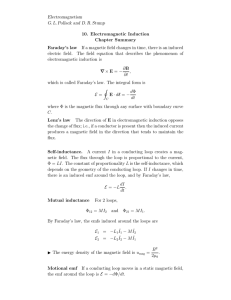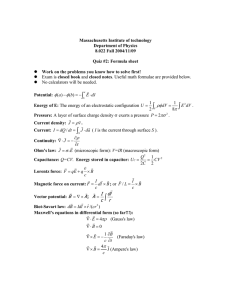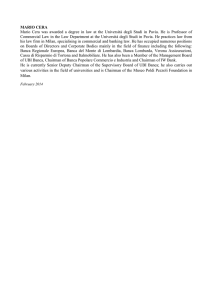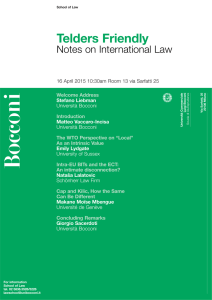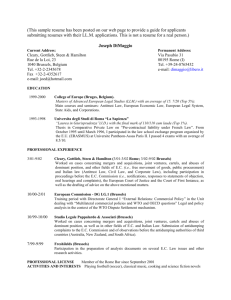Mutual inductance
advertisement
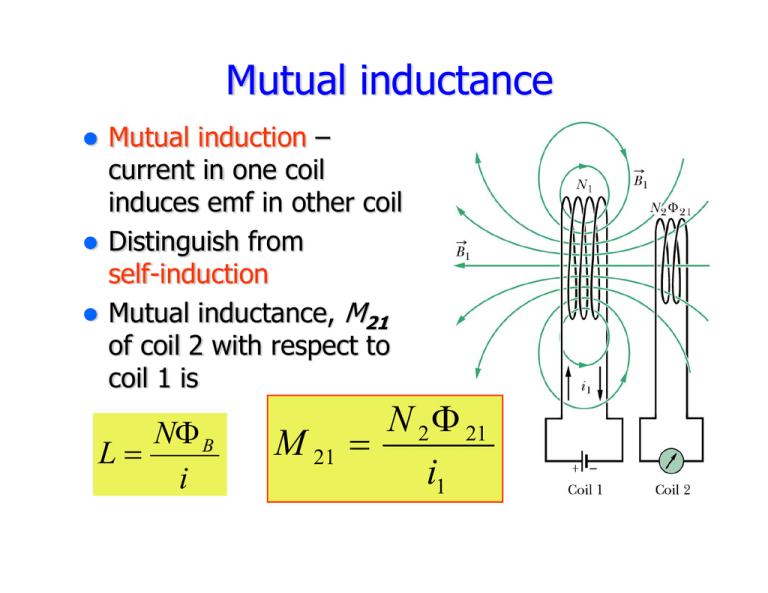
Mutual inductance z z z Mutual induction – current in one coil induces emf in other coil Distinguish from self-induction Mutual inductance, M21 of coil 2 with respect to coil 1 is NΦ B L= i M 21 N 2 Φ 21 = i1 Mutual inductance M 21 z N 2 Φ 21 = i1 Rearrange equation M 21i1 = N 2Φ 21 z z ε z 2 z dΦ 21 = −N2 dt Induced emf in coil 2 due to i in coil 1 is ε Vary i1 with time dΦ 21 di1 M 21 = N2 dt dt Faraday’s law 2 di1 = − M 21 dt Obeys Lenz’s law (minus sign) Mutual inductance z z z Reverse roles of coils What is induced emf in coil 1 from a changing current in coil 2? Same game as before M 12 ε 1 N 1Φ 12 = i2 di2 = − M 12 dt Mutual inductance z The mutual inductance terms are equal M 12 z N 1Φ 12 = i2 M 21 = M 12 = M Rewrite emfs as ε z M 21 N 2 Φ 21 = i1 2 di1 = −M dt ε 1 di2 = −M dt Notice same form as self-induced emf ε L di = −L dt NΦ B L= i Induced Electric Fields z Put a copper ring in a uniform B field which is increasing in time so the magnetic flux through the copper ring is changing z By Faraday’s law an induced emf and current are produced z If there is a current there must be an E field present to move the conduction electrons around ring Induced Electric Fields z z z Induced E field acts the same way as an E field produced by static charges, it will exert a force, F=qE, on a charged particle True even if there is no copper ring (the picture shows a region of magnetic field increasing into the board which produces circular electric field lines). Restate Faraday’s law – A changing B field produces an E field given by r r dΦ B ∫ E • ds = − dt No magnetic monopoles z z z z Magnetic monopoles do not exist Express mathematically as r r Φ B = ∫ B • dA = 0 Integral is taken over closed surface Net magnetic flux through closed surface is zero z As many B field lines enter as leave the surface Electric charge x no magnetic charge z Gauss’s law for E fields r r qenc Φ E = ∫ E • dA = ε0 z Gauss’s law for B fields r r Φ B = ∫ B • dA = 0 z Both cases integrate over closed Gaussian surface Faraday’s and Maxwell’s laws z Faraday’s law of induction E field is induced along a r r dΦ B closed loop by a changing E • ds = − dt magnetic flux encircled by that loop Is the reverse true? Maxwell’s law of induction B field is induced along a r r dΦ E closed loop by a changing B • ds = μ0ε 0 dt electric flux in region encircled by loop ∫ z z ∫ Ampere’s + Maxwell’s law r r ∫ B • ds = μ0ienc z Ampere’s law z Combine Ampere’s and Maxwell’s law r r dΦ E ∫ B • ds = μ0ε 0 dt + μ0ienc z B field can be produced by a current and/or a changing E field z z Wire carrying constant current, dΦE /dt = 0 Charging a capacitor, no current so ienc = 0 Maxwell’s laws z z z z Basis of all electrical and magnetic phenomena can be described by 4 equations called Maxwell’s equations As fundamental to electromagnetism as Newton’s law are to mechanics Einstein showed that Maxwell’s equations work with special relativity Maxwell’s equations basis for most equations studied since beginning of semester and will be basis for most of what we do the rest of the semester Maxwell’s laws Maxwell’s 4 equations are z z Gauss’ Law r r q ∫ E • dA = ε0 Gauss’ Law for magnetism r r ∫ B • dA = 0 r r d r r B • dA z Faraday’s Law ∫ E • ds = − ∫ dt z r r r r d Ampere-Maxwell Law B • ds = ε 0 μ0 E • dA + μ0i ∫ ∫ dt Maxwell’s laws in differential form z z z z Gauss’ Law r r ρ ∇•E = ; ε0 ρ = charge density r r Gauss’ Law for magnetism ∇ • B = 0 r r r dB Faraday’s Law ∇ × E = − dt r r r 1 dE r Ampere-Maxwell Law ∇ × B = + μ0 J 2 c dt r 1 2 c = ; J = current density μ 0ε 0
